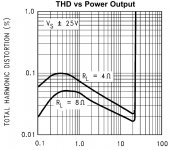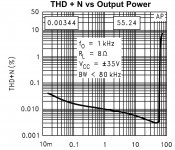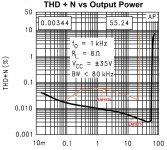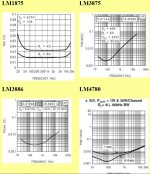For high efficiency 8 ohm speakers (Zu Omens), which would provide better sound quality between the LM1875 and LM3875, all else being equal (same passive components, etc.)? I'm looking at the Chipamp.com LM1875 kit and Peter's LM3875 kit.
I've been searching the forum but can't find conclusive answers.
This would be my first gainclone kit (I normally use a 300B SET)
I've been searching the forum but can't find conclusive answers.
This would be my first gainclone kit (I normally use a 300B SET)
Inverted with jlh buffer definitely sounds better to me than non-inverted. Have not built transconductance yet, so can not comment.
.
This is something of a no-brainer because the data sheet specs show the LM3875 to be hands-down better, case closed.
Case not closed. The first question is whether you can hear the difference. Some can, or say they can. Many can't. I personally am willing to bet that the audible difference--if any--is in how well any given speakers match up to any given amp. Critical consideration: amps don't produce sound, speakers do.
Beyond that, take a close look at the LM3875. There are thousands of pins, the thing is terrifying! OK maybe not thousands, maybe just 11. But that's a quantum leap beyond the 5 pins of the LM1875. Consider the pure mechanics of what you're doing.
Continuing with mechanics, the LM3875 requires a bigger (more expensive) transformer, more amperage and higher voltage. The power supply is an intrinsic part of any amp, you absolutely cannot scrimp.
Possibly most difficult of all is heat sinking the LM3875. Can you even get a heat sink that will work? Can you get two of them? We're talking pretty serious heat sinking, here.
These days it's a given that any little black chip produces first-quality sound. I guess sure, there's such a thing as super-first-quality, but it's a balancing act. Given the fact that you're kinda new at this, I personally think that the LM1875 would be a better choice. The cost is lower, your chance of success is higher, and don't worry, it will sound great.
.
This is something of a no-brainer because the data sheet specs show the LM3875 to be hands-down better, case closed.
Case not closed. The first question is whether you can hear the difference. Some can, or say they can. Many can't. I personally am willing to bet that the audible difference--if any--is in how well any given speakers match up to any given amp. Critical consideration: amps don't produce sound, speakers do.
Beyond that, take a close look at the LM3875. There are thousands of pins, the thing is terrifying! OK maybe not thousands, maybe just 11. But that's a quantum leap beyond the 5 pins of the LM1875. Consider the pure mechanics of what you're doing.
Continuing with mechanics, the LM3875 requires a bigger (more expensive) transformer, more amperage and higher voltage. The power supply is an intrinsic part of any amp, you absolutely cannot scrimp.
Possibly most difficult of all is heat sinking the LM3875. Can you even get a heat sink that will work? Can you get two of them? We're talking pretty serious heat sinking, here.
These days it's a given that any little black chip produces first-quality sound. I guess sure, there's such a thing as super-first-quality, but it's a balancing act. Given the fact that you're kinda new at this, I personally think that the LM1875 would be a better choice. The cost is lower, your chance of success is higher, and don't worry, it will sound great.
.
"Beyond that, take a close look at the LM3875. There are thousands of pins, the thing is terrifying! OK maybe not thousands, maybe just 11. But that's a quantum leap beyond the 5 pins of the LM1875."
first thing I do when working with LM3875 is to clip the not connected NC pins...that way they do not get in the way of components and short things and so on...so no problem there
I personally prefer the sound of LM1875 to LM3875, but other people may have opposite finding, the difference is no too big and as bentsnake mentioned, it may have something to do with rest of the system
first thing I do when working with LM3875 is to clip the not connected NC pins...that way they do not get in the way of components and short things and so on...so no problem there
I personally prefer the sound of LM1875 to LM3875, but other people may have opposite finding, the difference is no too big and as bentsnake mentioned, it may have something to do with rest of the system
For high efficiency 8 ohm speakers (Zu Omens), which would provide better sound quality between the LM1875 and LM3875, all else being equal (same passive components, etc.)? I'm looking at the Chipamp.com LM1875 kit and Peter's LM3875 kit.
I've been searching the forum but can't find conclusive answers.
This would be my first gainclone kit (I normally use a 300B SET)
It depends on your power requirements...
The LM1875 is capable of 20 Watt RMS and the LM3875 is capable of over 50 Watt RMS. Also THD+N is very good (0.003%) for the LM3875.
Why not read the datasheets?
Greetings,
Udo
Attachments
Last edited:
The LM1875 and 3875 are both 5 pin chip amps (only 5 active pins on 3875). Both can make under .1% distortion into 8 ohm loads which I consider hifi. I'd go 1875 for a first build. With high sensitivity speakers you get plenty of volume.
Be sure to get your parts from a reliable source such as Mouser, Digikey.... Lots of other places sell counterfeit parts (ebay). Power supply decoupling and proper grounding are paramount to a stable and low distortion amp.
Be sure to get your parts from a reliable source such as Mouser, Digikey.... Lots of other places sell counterfeit parts (ebay). Power supply decoupling and proper grounding are paramount to a stable and low distortion amp.
Udok's two attachments are quite revealing
At 20W of output one is showing 0.016% distortion.
The other is showing 0.0041% (11.8dB less distortion after NFB has been applied) and continues to fall to 0.003% @ 45W
At 20W of output one is showing 0.016% distortion.
The other is showing 0.0041% (11.8dB less distortion after NFB has been applied) and continues to fall to 0.003% @ 45W
yes, but do you listen at maximum output power AndrewT?
one thing I find interesting that while distortion of LM3875 is actually increasing with decreasing signal/power...that is not pointing to "0/0" but shooting up, typical of AB class, distortion of LM1875 goes down, poining to much lower crossover distortion, similar to class A amplifiers...just an observation
one thing I find interesting that while distortion of LM3875 is actually increasing with decreasing signal/power...that is not pointing to "0/0" but shooting up, typical of AB class, distortion of LM1875 goes down, poining to much lower crossover distortion, similar to class A amplifiers...just an observation
the rise in the slope at lower frequencies is usually due to the higher proportion that noise contributes to the THD+N
It is rarely due to an increase in distortion.
Again when one compares the THD+N at 0.1W you see that the left is showing 0.02%, whereas the right is showing 0.016%
It is rarely due to an increase in distortion.
Again when one compares the THD+N at 0.1W you see that the left is showing 0.02%, whereas the right is showing 0.016%
Last edited:
Again when one compares the THD+N at 0.1W you see that the left is showing 0.02%, whereas the right is showing 0.016%
AndrewT, are you saying you can hear the difference in 0.020 vs. 0.016 % distortion?
If you personally prefer one chip to other, that's fine, but to state that...you know what, forget it.
This conversation started with noticing that a recent post showing some test results.
Listening was not required in seeing that post.
I don't know If I can hear distortion differences between two different amplifiers based on test results published without supporting data.
You're right, introducing your red herring is worth forgetting.
Listening was not required in seeing that post.
Udok's two attachments are quite revealing...............
.........but do you listen at maximum output power AndrewT? .................that is not pointing to "0/0" but shooting up, typical of AB class, distortion of LM1875 goes down, poining to much lower crossover distortion, similar to class A amplifiers...just an observation
the rise in the slope at lower frequencies is usually due to the higher proportion that noise contributes to the THD+N
It is rarely due to an increase in distortion.
Again when one compares the THD+N at 0.1W you see that the left is showing 0.02%, whereas the right is showing 0.016%
I probably do listen at maximum power. It might be for 10us each alternate minute.AndrewT, are you saying you can hear the difference in 0.020 vs. 0.016 % distortion? ...................., forget it.
I don't know If I can hear distortion differences between two different amplifiers based on test results published without supporting data.
You're right, introducing your red herring is worth forgetting.
I put the distortion graphs from the datasheets in one picture so that the difference is clearly seen.
The LM1875 has no data below 0.1 Watt.
THD+N at 10 kHz is 0.04% @ 40Watt for LM3875 and 0.02% @10Watt for LM1875
Price for LM3875 is doubled in comparison to LM1875
The LM1875 has no data below 0.1 Watt.
THD+N at 10 kHz is 0.04% @ 40Watt for LM3875 and 0.02% @10Watt for LM1875
Price for LM3875 is doubled in comparison to LM1875
Attachments
Standing quietly in a corner he murmured as if to himself, the price is a lot more than double when you figure in the transformer and heat sink.
Last edited:
As he uses a high efficient speaker he will never go near 20W anyway, so he can use the same transformer and sink. His only question is which sounds better. Doesn't care about the + power of 3875 as he will not use it. With those speakers 2W means 100dB already. Also don't know why ppl got stuck on THD. Anyone cares about any tube amps THD? No... question is the sound. Which one sounds better. I also have both 1875 and 3875 amp, but one has regulated supply, other not and also didn't compare them really so will not make suggestions.
Last edited:
The LM1875 has a horrible switch-off pop. Switching on is fine.
It sounds much better than 3875 (subjectively IME) and is also very easy to put together. You will see that the maximum output of the 1875 is around 30W/4ohm/30V rails, whereas the 3875/3886 etc usually deliver much higher power at that rail, the benefits of newer technology, and so on. For example at 25V rails and a gentle 8 ohm load two 1875s really toast a sink whereas the 3875 runs cool.
Still, to the ears the 1875 seems to be shade better. I'm guessing if you don't have the two side by side you wouldn't know the difference. I run a 3875 in the bedroom, it replaced the 1875 as the speakers aren't too efficient. It is quite an enjoyable experience if you have taken good care with layout, wiring and component choices.
It sounds much better than 3875 (subjectively IME) and is also very easy to put together. You will see that the maximum output of the 1875 is around 30W/4ohm/30V rails, whereas the 3875/3886 etc usually deliver much higher power at that rail, the benefits of newer technology, and so on. For example at 25V rails and a gentle 8 ohm load two 1875s really toast a sink whereas the 3875 runs cool.
Still, to the ears the 1875 seems to be shade better. I'm guessing if you don't have the two side by side you wouldn't know the difference. I run a 3875 in the bedroom, it replaced the 1875 as the speakers aren't too efficient. It is quite an enjoyable experience if you have taken good care with layout, wiring and component choices.
- Status
- Not open for further replies.
- Home
- Amplifiers
- Chip Amps
- LM1875 or LM3875 ???




